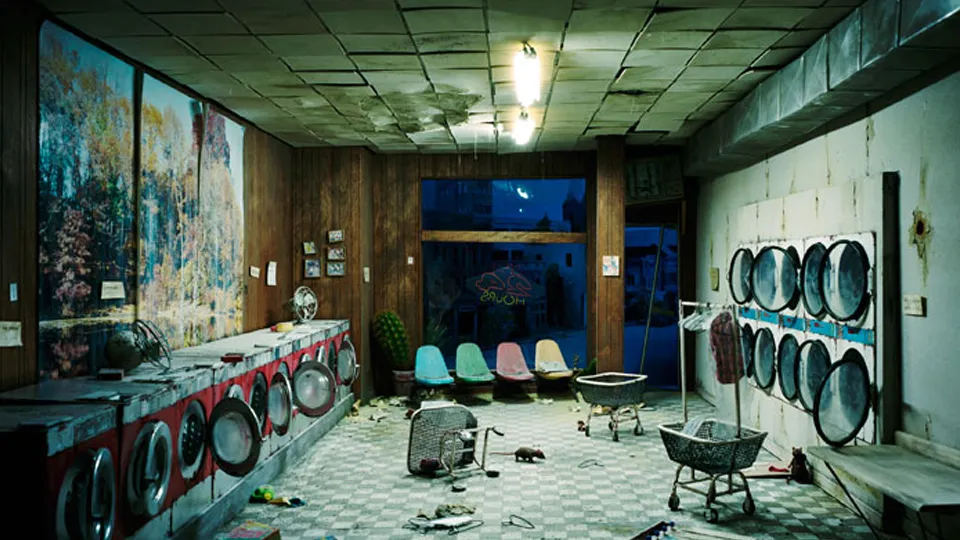In a world grappling with environmental collapse and resource depletion, designers are turning toward reclaimed materials to forge a new aesthetic that merges survival with sustainability.
The apocalyptic design movement represents more than just a trend—it’s a philosophical shift in how we perceive beauty, functionality, and our relationship with the built environment. As cities expand and natural resources dwindle, the concept of reclaiming what already exists has evolved from necessity into an art form that celebrates resilience and creativity.
This approach to design doesn’t simply embrace recycling; it reimagines entire structural systems through the lens of scarcity and adaptation. Reclaimed materials—from weathered timber to salvaged metals—carry stories within their surfaces, transforming spaces into narrative experiences that connect past, present, and an uncertain future.
🌍 The Philosophy Behind Apocalyptic Aesthetics
Apocalyptic design emerged from a convergence of environmental awareness, post-industrial landscapes, and speculative fiction. This aesthetic acknowledges the fragility of modern civilization while proposing solutions grounded in resourcefulness. Unlike traditional design paradigms that prioritize pristine materials and perfection, apocalyptic design celebrates imperfection, patina, and the visible history of materials.
The movement draws inspiration from various sources: abandoned factories in Detroit, post-war reconstruction efforts, survival architecture, and even dystopian cinema. These influences create a visual language that feels simultaneously ancient and futuristic, raw yet refined.
Designers working in this realm view reclaimed materials not as second-choice alternatives but as primary resources with inherent value. A rusted steel beam tells the story of decades supporting a warehouse; reclaimed brick carries the character of fires survived and weather endured. These materials bring authenticity that newly manufactured products simply cannot replicate.
The Psychology of Reclaimed Spaces
There’s something profoundly human about spaces constructed from reclaimed materials. They trigger our innate appreciation for things that have endured, survived, and adapted. This psychological connection creates environments that feel lived-in from day one, eliminating the sterile quality often associated with new construction.
Research in environmental psychology suggests that spaces incorporating natural materials and visible age promote wellbeing and reduce stress. The imperfections in reclaimed wood, the variations in salvaged stone, and the weathering of recycled metals create visual interest that engages our pattern-seeking minds without overwhelming them.
♻️ Material Revolution: What Can Be Reclaimed
The spectrum of reclaimable materials has expanded dramatically as awareness and infrastructure have developed. What was once considered construction waste now represents valuable inventory for forward-thinking designers and builders.
Structural Elements With Second Lives
Timber remains the most commonly reclaimed material, sourced from demolished barns, decommissioned railway trestles, and old-growth forests that were logged generations ago. These beams and boards often feature grain patterns and wood density that modern lumber cannot match, as they came from trees that grew slowly over centuries.
Steel and iron from industrial structures provide robust framing materials with exceptional strength characteristics. Factory beams, shipping containers, and bridge components can be transformed into architectural features that support substantial loads while serving as dramatic visual elements.
Brick and masonry from historic buildings offer thermal mass and aesthetic warmth. Each brick bears the marks of its previous incarnation—soot stains, mortar residue, chips, and weathering—creating texture that adds depth to interior and exterior walls.
Unexpected Treasures in the Waste Stream
- Shipping pallets transformed into furniture, wall cladding, and decorative elements
- Automotive parts repurposed as lighting fixtures and industrial accents
- Glass bottles melted and reformed into countertops and decorative panels
- Copper plumbing and electrical wire transformed into artistic installations
- Concrete rubble crushed and used as aggregate in new construction
- Textile waste from industrial processes woven into insulation and acoustic panels
- Plastic waste compressed into composite building materials
- Rubber tires shredded for flooring and landscaping applications
🏗️ Implementing Reclaimed Materials in Modern Design
Successfully integrating reclaimed materials requires careful planning, creative problem-solving, and technical expertise. Unlike standardized new materials, reclaimed resources come with unique challenges regarding sizing, structural integrity, and treatment requirements.
The first consideration involves sourcing. Architectural salvage yards, demolition companies, online marketplaces, and specialized reclamation businesses provide access to materials, but each piece must be evaluated individually. Structural timber needs inspection for rot, insect damage, and load-bearing capacity. Metal requires assessment for corrosion, stress fractures, and contamination.
Technical Considerations and Building Codes
Building codes present both obstacles and opportunities when working with reclaimed materials. Many jurisdictions have developed pathways for certifying salvaged structural elements, recognizing their environmental benefits. Engineers can test and rate reclaimed timber and steel, providing documentation that satisfies code requirements.
Treatment processes ensure safety and longevity. Reclaimed wood often undergoes kiln drying to eliminate pests, followed by cleaning and sometimes refinishing. Metal may require sandblasting, treatment for rust, and protective coating. These processes preserve the material’s character while preparing it for its new application.
| Material Type | Primary Challenges | Treatment Solutions | Best Applications |
|---|---|---|---|
| Reclaimed Wood | Inconsistent dimensions, potential pests | Kiln drying, milling, stabilization | Flooring, beams, accent walls |
| Salvaged Metal | Corrosion, structural integrity | Testing, sandblasting, coating | Structural frames, decorative features |
| Reclaimed Brick | Mortar removal, breakage | Cleaning, sorting, stabilization | Walls, paving, facades |
| Salvaged Glass | Safety, irregular sizing | Edging, tempering, framing | Windows, partitions, artistic elements |
🎨 Aesthetic Strategies for Post-Apocalyptic Spaces
Creating compelling apocalyptic design requires more than simply assembling reclaimed materials. The aesthetic balances rawness with refinement, chaos with intentionality. Successful projects establish visual hierarchies that guide the eye while celebrating the inherent beauty of aged materials.
Texture plays a central role in this design language. Combining rough-hewn timber with smooth concrete, weathered metal with polished glass creates dynamic contrast that energizes spaces. These juxtapositions prevent monotony while highlighting each material’s unique qualities.
Color Palettes of Survival and Renewal
The color palette of apocalyptic design draws from industrial and natural sources. Rust oranges, weathered grays, charcoal blacks, and oxidized copper greens form the foundation. These colors occur naturally as materials age and interact with their environment, requiring no additional finishing.
Accent colors often come from unexpected sources—the blue-green patina of aged copper, the warm honey tones of reclaimed heart pine, or the deep burgundy of oxidized steel. These organic variations create color schemes impossible to replicate through paint or manufactured materials.
Lighting Design for Dramatic Effect
Lighting transforms reclaimed materials from mere building components into sculptural elements. Strategic illumination highlights texture, casts dramatic shadows, and emphasizes the three-dimensional quality of weathered surfaces. Industrial fixtures complement the aesthetic while providing functional illumination.
Natural light interacts beautifully with reclaimed materials throughout the day, creating ever-changing patterns as sun angles shift. Skylights, large windows, and reflective surfaces distribute daylight while reducing energy consumption—a practical consideration aligned with sustainable principles.
🌱 Environmental Impact and Sustainability Metrics
The environmental case for reclaimed materials extends beyond the obvious benefit of diverting waste from landfills. Every reclaimed beam, brick, or sheet of metal represents embodied energy—the total energy required to extract raw materials, manufacture, and transport them. Reusing these materials preserves that embodied energy while avoiding the environmental costs of producing new materials.
Wood reclamation prevents deforestation and carbon emissions. Steel salvage reduces mining operations and the energy-intensive smelting process. Brick reuse eliminates the need for firing new units, a process that consumes substantial fossil fuels and releases greenhouse gases.
Quantifying the Benefits
Life cycle assessments demonstrate the dramatic environmental advantages of reclaimed materials. Using salvaged timber instead of new wood can reduce carbon emissions by 75% or more. Reclaimed steel carries approximately one-tenth the carbon footprint of virgin steel. These metrics make reclaimed materials essential tools in combating climate change through design.
Water conservation represents another significant benefit. Manufacturing new materials requires enormous water quantities for processing, cooling, and cleaning. Reclaimed materials bypass these water-intensive processes, preserving this increasingly precious resource.
🔨 Practical Projects: Getting Started With Reclaimed Design
Implementing apocalyptic design principles doesn’t require massive budgets or complete renovations. Strategic interventions using reclaimed materials can transform spaces while developing skills and confidence for larger projects.
Entry-Level Applications
Begin with accent walls constructed from reclaimed wood planks. This manageable project introduces material sourcing, preparation techniques, and installation methods. The visual impact far exceeds the effort required, creating a focal point that establishes the aesthetic direction for entire rooms.
Furniture construction offers another accessible entry point. Simple designs like tables, benches, and shelving require minimal tools while showcasing reclaimed materials’ inherent beauty. Imperfections become design features rather than flaws to hide or correct.
Intermediate Challenges
Flooring installation using reclaimed wood planks demands more technical skill but delivers transformative results. Each plank’s unique character creates floors with unmatched visual interest. The project teaches important lessons about material preparation, moisture management, and finishing techniques.
Incorporating salvaged architectural elements—doors, windows, lighting fixtures—into renovations adds instant character while developing sourcing networks and adaptation skills. These elements serve as conversation pieces that anchor design narratives.
💡 Innovation in Material Processing and Application
The reclaimed materials industry continues evolving, developing new technologies and techniques that expand possibilities. Advanced cleaning systems remove contaminants while preserving patina. Digital scanning and modeling allow precise measurement of irregular reclaimed pieces, facilitating integration with contemporary construction methods.
Composite materials blend reclaimed wood fiber with binding agents to create dimensionally stable products suitable for applications where solid reclaimed lumber proves impractical. These innovations maintain the environmental benefits while addressing technical limitations.
Digital Tools Revolutionizing Reclamation
Online marketplaces connect buyers with salvage operations worldwide, dramatically expanding access to reclaimed materials. Sophisticated search filters help identify specific materials, dimensions, and aesthetic qualities. Virtual reality previews allow designers to visualize reclaimed materials in their projects before committing to purchases.
Building information modeling (BIM) software now accommodates irregular reclaimed materials, enabling precise planning despite dimensional variations. These digital tools bridge the gap between traditional craftsmanship and modern construction management.
🌟 Cultural Shift Toward Conscious Consumption
Beyond environmental and aesthetic considerations, embracing reclaimed materials reflects deeper cultural changes. Consumers increasingly value authenticity, transparency, and conscious consumption. They seek products and spaces with genuine stories rather than manufactured narratives.
This shift challenges the disposable mentality that dominated recent decades. Instead of viewing objects as temporary conveniences, we’re rediscovering appreciation for durability, craftsmanship, and the patina that develops through use and time. Reclaimed materials embody these values tangibly.
Education and Community Building
Workshops, courses, and online communities foster knowledge sharing around reclaimed material techniques. Experienced craftspeople mentor newcomers, passing along skills that might otherwise disappear. This collaborative spirit strengthens local communities while preserving traditional knowledge relevant to sustainable futures.
Educational institutions increasingly incorporate reclaimed materials into architecture and design curricula. Students learn to view waste streams as resource libraries, developing creative problem-solving skills essential for addressing environmental challenges.
🚀 Future Trajectories in Apocalyptic Design
As climate pressures intensify and resource constraints tighten, design approaches prioritizing reclamation will shift from alternative to mainstream. Regulatory frameworks increasingly favor low-carbon materials, creating financial incentives for choosing reclaimed options. Carbon pricing mechanisms may make virgin materials prohibitively expensive, accelerating the transition.
Technological advances will continue improving reclaimed material processing, making it easier and more cost-effective. Artificial intelligence could optimize material matching, connecting specific reclaimed pieces with ideal applications. Automated sorting and cleaning systems may reduce labor costs while improving consistency.
The aesthetic itself will likely evolve, incorporating new material sources as different industries decline and their waste streams become available. Solar panel components, wind turbine blades, and other renewable energy infrastructure will eventually reach end-of-life, presenting opportunities for creative reuse that extend their environmental benefits.
Regenerative Design Beyond Sustainability
The next frontier moves beyond sustainability toward regenerative design—creating built environments that actively improve ecological systems. Reclaimed materials play crucial roles in these approaches, but the vision extends further. Imagine buildings that purify air and water, generate more energy than they consume, and provide habitat for urban wildlife, all while incorporating materials salvaged from previous structures.
This holistic vision recognizes that truly sustainable futures require redesigning entire systems rather than making incremental improvements. Reclaimed materials represent one component of comprehensive strategies addressing climate change, resource depletion, and social equity simultaneously.
The apocalyptic design movement offers more than aesthetic innovation—it provides practical pathways toward resilient, sustainable futures. By embracing reclaimed materials, we acknowledge past mistakes while demonstrating our capacity to learn, adapt, and create beauty from what others discard. These materials remind us that endings can become beginnings, that destruction contains seeds of renewal, and that conscious choices today shape the world we’ll inhabit tomorrow. The textures, colors, and stories embedded in reclaimed materials ground us in physical reality while inspiring hope that human creativity can solve the challenges we face.
Toni Santos is a visual explorer and microscopic storyteller who delves into the hidden aesthetics of microbial life. Through a fusion of scientific curiosity and artistic insight, Toni transforms the overlooked world of bacteria, fungi, and cellular forms into mesmerizing visual narratives—revealing the elegance, symmetry, and chaos that thrive at microscopic scales.
Rooted in a fascination with life forms too small to see yet too intricate to ignore, Toni’s work captures the bizarre beauty of microbial colonies, biofilms, and spore patterns. These images aren’t just representations—they are celebrations of the artistic intelligence encoded in nature’s tiniest architects.
With a background in visual design and bio-inspiration, Toni merges scientific imaging techniques with creative expression, transforming petri dish cultures, fluorescence microscopy, and microbial textures into works that provoke both wonder and contemplation.
As the creative force behind Vizovex, Toni offers curated visual studies, microbial-inspired designs, and essays that bridge art and microbiology—inviting viewers to reimagine what beauty means at the edge of perception.
His work is a tribute to:
The hidden geometries of living systems
The surprising elegance of microbial growth
The role of micro-life in shaping visual culture
Whether you’re a scientist, artist, or simply curious about the unseen world that sustains us, Toni opens a window into a universe where life writes poetry in colonies and patterns, one microbe, one frame, one breathtaking detail at a time.





